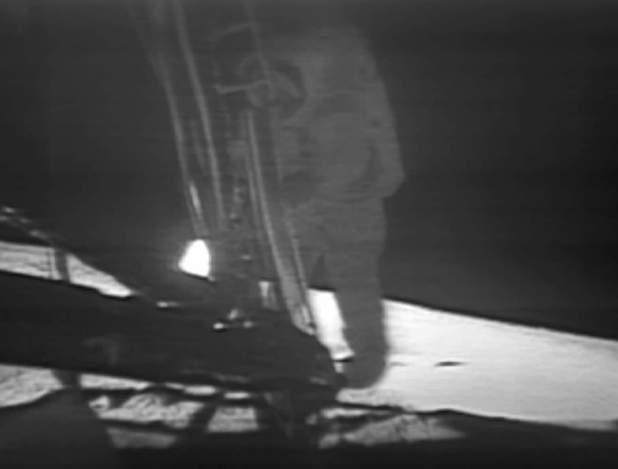
Fifty years ago, yesterday, on 18 March 1965, humanity became an “extravehicular” spacefaring civilization for the first time, when 30-year-old Soviet cosmonaut Alexei Leonov ventured outside his Voskhod 2 spacecraft and spent 12 minutes floating in the void. By the fall of 1966, no fewer than five U.S. astronauts had done likewise, with Gemini XII’s Buzz Aldrin spending a cumulative 5.5 hours outside his ship in three discrete sessions of Extravehicular Activity (EVA). As described in yesterday’s AmericaSpace article, spacewalking was considered a crucial step toward the U.S. goal of accomplishing bootprints on the Moon before the end of the decade. However, the astronauts had come face to face with the hazardous realities and difficulties of EVA, and the first efforts had begun to develop better training analogs on the ground.
By the dawn of 1967, five U.S. spacewalkers—Ed White, Gene Cernan, Mike Collins, Dick Gordon, and Buzz Aldrin—had ventured outside their respective spacecraft. With the loss of the Apollo 1 crew in a catastrophic fire on the launch pad and the tragic death of Soviet cosmonaut Vladimir Komarov during the failed re-entry of Soyuz 1, both the U.S. and Soviet human space programs ground to a halt for almost two years, and it was not until January 1969 that spacewalkers again emerged from their craft. On that occasion, Soviet cosmonauts Alexei Yeliseyev and Yevgeni Khrunov performed the first multi-person spacewalk, maneuvering from the docked Soyuz 5 to Soyuz 4 spacecraft and becoming the first crew members to return to Earth in a different craft to the one in which they launched. Their experience demonstrated that “spacewalking” was something of a misnomer and that the most efficient form of locomotion was a hand-over-hand progression, using rails and handholds on the exterior of the spacecraft.
In March 1969, U.S. astronauts Jim McDivitt, Dave Scott, and Rusty Schweickart were launched on a full dress rehearsal of the complete Apollo spacecraft—command, service, and lunar modules—in low-Earth orbit. During the course of the Apollo 9 mission, it was intended that McDivitt and Schweickart would undock the lunar module from Scott in the command module and perform formation-flying. Additionally, Schweickart would perform an EVA outside the lunar module, wearing a similar suit to that planned for the first landing on the Moon. However, there existed another EVA element to Apollo 9. If a problem arose preventing the lunar module from redocking with the command and service module, McDivitt and Schweickart would have been required to perform a spacewalking transfer. This was hampered by the fact that McDivitt, who was not scheduled to perform an EVA, would have been wholly reliant upon the emergency oxygen supply in Schweickart’s suit. “If he didn’t make the EVA transfer within 45 minutes,” wrote Dave Scott in his memoir, Two Sides of the Moon, “he would die.”
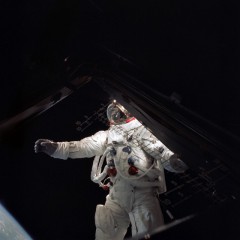
Schweickart’s EVA was compounded by a severe bout of space sickness, which seriously forced mission managers to consider curtailing or even canceling it. The plan called for the spacewalk to occur whilst the two spacecraft were still docked and would have seen him spend 135 minutes outside, exiting the lunar module’s square hatch and making his way, via handrails, over to the open hatch of the command module, where a fully-suited Scott would perform a stand-up EVA to photograph his progress. As well as evaluating how well the suit held up to “real” radiation and vacuum conditions, it would also serve as a test of how well a returning lunar surface crew could spacewalk over to the command module in the event that they were unable to pass through the docking tunnel.
In light of Schweickart’s sickness, the tasks were hurriedly reprioritized and culminated in a relatively straightforward, 45-minute opening of the hatch, exposing him and McDivitt and their suits to vacuum, but keeping them both inside the lunar module. Fortunately, Schweickart recovered and the EVA went ahead. Anchored by a tether, he squeezed through the hatch and onto the lunar module’s porch, clad in the “A7L” suit, built by ILC Dover of Delaware. It incorporated integrated thermal and micrometeoroid layers and consisted of a single-piece “torso-limb” structure, with convoluted joints of synthetic rubber at its shoulders, elbows, wrists, hips, ankles, and knees, and a system of “link-net” mesh to keep it from ballooning under pressure. Metallic rings at the neck and forearms provided for the attachment of helmet and gloves.
“What was important about this EVA,” explained Deke Slayton in his autobiography, Deke, “was that the lunar pressure suit was completely self-contained. All the suits used on the Gemini EVAs had relied on the spacecraft to provide oxygen and communications.” With the Apollo suit, all of this resided in the massive Portable Life Support System (PLSS) backpack. Moving outside, Schweickart fastened himself into a pair of “golden slippers” on the porch, as Dave Scott—connected to the command module’s life-support utilities—poked his own helmeted head into space for a stand-up EVA. Schweickart captured impressive film footage of Scott, as well as imagery of both spacecraft, before returning back inside the lunar module. The suit which would sustain the first Moonwalkers had passed its initial testing in the space environment with flying colors.
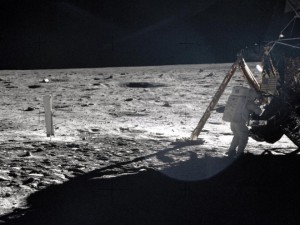
With the conclusion of Apollo 9, the next time an American citizen would venture outside his spacecraft would be the initial steps of Neil Armstrong and Buzz Aldrin on the surface of the Moon in July 1969. Original plans called for the astronauts to sleep after achieving humanity’s first landfall on an alien world, but that proved about as likely as telling a child to sleep on Christmas morning, and Armstrong elected shortly after touchdown to press ahead with “EVA Prep.” Donning their lunar surface equipment—rubber-soled boots, backpacks, oxygen hoses, coolant umbilicals, outer helmets, and chest-mounted control packs—took time and was exacerbated by the cramped nature of the lunar module’s cabin, which Aldrin later described as akin to a pair of fullbacks in a Cub Scout tent.
At length, the square hatch was opened and Armstrong dropped to his knees, his head facing the rear of the cabin, and planted his feet into the opening which marked the threshold to the Moon. The images which followed retain their ethereal quality, even decades later, as he maneuvered onto the porch and descended the nine-rung ladder to the surface. At 10:56:15 p.m. EDT on 20 July 1969, with the immortal words “That’s one small step for man, one giant leap for mankind,” he became the first representative of humanity to set foot on another world, a mere four years since EVA had first been pioneered. Aldrin joined him in short order and the two men set up experiments and the U.S. flag, gathered soil and rock samples, and spoke directly to President Richard Nixon, who congratulated them on their achievement.
Performing EVA on another celestial body, they found that the most natural gait was a loping motion, in which they alternated feet, pushed off with each step, and floated ahead, then planted the other foot. Other techniques included “skipping strides” and “kangaroo hops,” necessitated by the peculiar one-sixth terrestrial gravity. They had to take care when turning and stopping. “I noticed immediately that my inertia seemed much greater,” Aldrin wrote in his memoir, Men from Earth. “Earthbound, I would have stopped my run in just one step … an abrupt halt. I immediately sensed that if I tried this on the Moon, I’d be face-down in the lunar dust. I had to use two or three steps to sort of wind down. The same applied to turning around. On Earth, it’s simple, but on the Moon, it’s done in stages.” In total, Armstrong spent two hours and 14 minutes on the surface; Aldrin a little less, at one hour and 46 minutes.
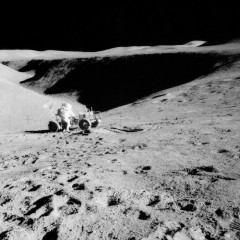
Over the course of the next 3.5 years, a further 10 U.S. citizens would walk the surface of the Moon, spending increasingly longer durations outside the lunar module and embarking on increasingly more complex tasks. On Apollo 12 in November 1969, astronauts Charles “Pete” Conrad and Al Bean performed two EVA sessions on the surface, retrieving equipment from the Surveyor 3 lander, establishing experiments, digging trenches, and collecting, documenting, and photographing rock and soil samples. The one-sixth terrestrial gravity carried its own peculiarities. “A simple thing like shoveling soil into a sample bag was an entirely new experience,” explained Conrad. “First, you had to handle the shovel differently, stopping it before you would have on Earth, and tilting it to dump the load much more steeply, after which the whole sample would slide off suddenly.” Hopes to acquire color TV footage had been ruined by inadvertently pointing the camera directly at the Sun, and efforts to take a photograph of Conrad and Bean together had failed when the timer disappeared. It was discovered toward the end of the second EVA, too late for them to take what would have been a remarkable—and historically unique —image.
With two Moonwalks having been scheduled for Apollo 13, the objectives of this “Successful Failure” to land at the Fra Mauro highland site was moved to the next flight, Apollo 14, in January 1971. Astronauts Al Shepard and Ed Mitchell performed two EVAs, utilizing a two-wheeled Modular Equipment Transporter (MET) to carry their tools. Unfortunately, it tended to become bogged down in lunar dust, which proved thicker than the soils encountered by the Apollo 11 and 12 crews, and was likened to dragging a golf buggy through deep sand. The situation was worsened by the fact that it was also lightweight and tended to bounce in the low lunar gravity, meaning that one man had to follow behind, picking up items which fell off.
Shepard and Mitchell noticed that walking on an alien world proved difficult in other ways, too, since the harsh glare of sunlight made shadows unreliable and rendered distance impossibly hard to judge. With no visible points of reference, craters seemed to appear at their feet, as if from nowhere, and boulders which seemed to be some way off were suddenly upon them. This proved particularly troublesome when, during their second EVA, they attempted to find the rim of the large Cone Crater—one of their major geological objectives—but “checkpoint” craters on their map were hard to identify and the whole region seemed to be an endless sea of sand dunes. Sometimes, Shepard wrote in third-person narrative in Moon Shot, a joint memoir with Deke Slayton, “they would appear to walk along flat ground, when their legs disappeared and reappeared, like small ships on a heaving sea.” It was like trying to find one’s way across the featureless expanse of the Sahara Desert. They never reached the rim of Cone Crater, but subsequent analysis determined that they got within about 60 feet (20 meters) of doing so.
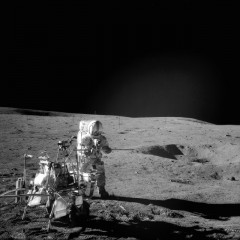
Aged 47, Shepard became the world’s oldest person to participate in an EVA, a record that he would hold for more than a decade, until STS-6 and the shuttle program’s first spacewalk in April 1983. From a public affairs perspective, the final stages of the second Moonwalk were marked by Shepard performing the first golf shot on another world. Using the handle of the contingency sample tool, fitted with “a genuine six-iron,” he whacked a golf ball into the distance. The stiffness of his suit meant that he could only operate one-handed, causing him to miss the first shot, whilst the second resulted in a pathetic dribble, but he succeeded on the third attempt. Before launch, Shepard had told Deke Slayton that he would only attempt the stunt if everything else had gone well, and he even sneaked out of crew quarters on a couple of occasions, donned his suit, and practiced his swing.
The final three lunar landings—Apollo 15 in July 1971, Apollo 16 in April 1972, and Apollo 17 in December 1972—saw astronauts Dave Scott, Jim Irwin, John Young, Charlie Duke, Gene Cernan, and Jack Schmitt perform nine Moonwalks, totaling more than 60 cumulative hours on the surface. The missions also featured the Lunar Roving Vehicle (LRV), which enabled far greater distances to be traveled and enabled a broader range of geological sampling activities.
Apollo 15 was also notable in that it featured the only Stand-Up EVA (SEVA) on the Moon, in which Scott opened the lunar module’s overhead hatch, stood on the ascent engine cover, and poked his head outside to conduct a 360-degree geological inspection of the landing site. The idea had met opposition from some NASA managers, including Deke Slayton, on the grounds that it would waste valuable oxygen, but Scott countered that it would be invaluable before embarking on his three Moonwalks with Irwin. He pulled a Lunar Excursion Visor Assembly over his helmet and described the 33-minute experience as “rather as if I was in the conning tower of a submarine or the turret of a tank.” Meanwhile, Irwin shielded the instrument panel from the harsh lunar sunlight and arranged Scott’s oxygen hoses and communications cables to enable him to stand upright. “He offered me a chance to look out,” wrote Irwin in his 1973 autobiography, To Rule the Night, “but my umbilicals weren’t long enough and I didn’t want to take the time to rearrange them.”
In the weak lunar gravity, Scott could easily support himself in the hatch on his elbows and employed a bearing indicator and large orientation map to shoot a couple of dozen interconnected stereo photographs of the landing site. “The SEVA was a marvellous and useful experience, for a lot of reasons,” Scott later told the Apollo Lunar Surface Journal. “One of our problems at Hadley was that the resolution of the Lunar Orbiter photography was only 60 feet (20 meters), so they couldn’t prepare a detailed map. The maps we had were best guesses and we had the radar people tell us before the flight that there were boulder fields—massive boulders—all over the base of Hadley Delta, just boulders everywhere. So another reason for the Stand-Up EVA was to look and see if we could drive the Rover, because if there were boulder fields down there, and nobody could prove there were no boulder fields, it changed the whole picture.”
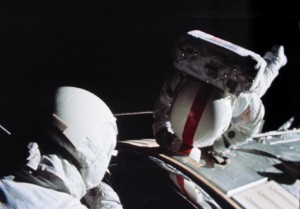
During the return journeys of Apollo 15, 16, and 17, the Command Module Pilots (CMPs)—Al Worden, Ken Mattingly, and Ron Evans respectively—each performed a “Deep Space EVA” to retrieve camera film from the exterior of the service module. These excursions were done in the “cislunar” environment, about 180,000 miles (300,000 km) from Earth and, to the present day, they mark the farthest spacewalks ever performed. “The EVA itself was kind of unique,” Worden recalled in his NASA oral history of his own 39-minute spacewalk, “sort of a unique perspective. I could see the Moon and the Earth at the same time; and if you’re on Earth, you can’t do that, and if you’re on the Moon, you can’t do that. It’s a very unique place to be!” Since the entire cabin was reduced to vacuum, Scott and Irwin were also required to don their own suits.
Since they were so far from home, the experience was quite distinct from “traditional” EVAs in low-Earth orbit. They were surrounded by the pitchest blackness, and one of the few sources of light was sunlight reflecting off the surfaces of the service module. Irwin considered it strange and eerie from his perch just inside Endeavour’s hatch, in silhouette against the full disk of the Moon. “The National Geographic did a painting of me,” he wrote in To Rule the Night. “It almost looks like a photo.” It is a pity that real photographs of what must have been an absolutely stunning event were never returned.
Such awe-inspiring views can only be described in the words of the men who experienced them. Occasionally, on Apollo 16, Ken Mattingly took a few seconds to look around at the blackness which surrounded him. The apparent absence of stars astounded him, and he was captivated by the view of a crescent Earth and the clear Moon, just 50,000 miles (80,000 km) away. One item which was safely returned by Ken Mattingly during his Deep-Space EVA on Apollo 16 was his wedding ring. In addition to collecting film packages, he was also tasked with gathering experiment packages, but had misplaced his wedding ring inside the command module’s cabin and presumed it lost. Fortunately, Charlie Duke spotted it, floating out of the hatch, and Mattingly was able to grab it before it was gone.
By the time the final Apollo crew returned from the Moon in December 1972, a mere 7.5 years had elapsed since history’s first spacewalk, and humans had reached and explored the lunar surface and performed EVAs in the cislunar void, betwixt the two celestial bodies. Almost five decades later, no EVAs of such enormous distance have been performed, and it seems unlikely that any will be undertaken for at least the next decade, but they marked a substantial advancement in capability in a very short period. In tomorrow’s article to commemorate 50 years of EVA, AmericaSpace will explore the development of tools and techniques to work outside Earth-orbital space stations and how these helped to lay the groundwork for today’s International Space Station (ISS).
The third part of this series will appear on Saturday.
Want to keep up-to-date with all things space? Be sure to “Like” AmericaSpace on Facebook and follow us on Twitter: @AmericaSpace




I have greatly enjoyed parts 1 and 2, and am looking forward to part 3!